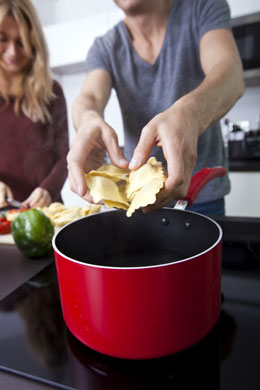
From weighing out your ingredients, to using smaller plates and glasses, there are lots of simple ways to keep things in proportion in the kitchen.
Regain some control at meal time with these simple tips.
Pre-portion your foods
Don't snack directly from a box, bag or container that contains multiple servings of food such as a family size bag of crisps or a tub of ice cream.
It's so easy to eat more than you should. Make sure that you measure out the right portion and don't be tempted to stick your hand back in for one more nibble.
Weigh your food
Use kitchen scales to weigh your ingredients or food before you cook. This will help you stick to the suggested serving sizes.
It's also a very eye opening way of seeing just how many chips are in a recommended serving!
You're in with a chance of winning some perfectly portioned serving utensils if you sign up for our Portion Size Wise challenge.
Eat with smaller plates and bowls
You eat with your eyes as well as your mouth and just downsizing your plates and bowls can make a big difference in how you perceive your portions. You'll eat less and still feel satisfied.
Aim for 2 portions of vegetables on your plate
This helps to cover your plate with low-calorie, filling food, leaving less room for higher calorie ingredients.
This will also help towards getting your 5 a day!
Healthy recipes
Start off well by choosing low fat, healthy recipes to make. You can check the calorie content of thousands of items.
You can also try some Portion Size Wise recipes.
Get the balance right
There are lots of helpful tools out there that can guide you in getting the right balance of food on your plate.
The NHS Eatwell guide is one way you can plan a perfectly balanced diet.
Five food groups make up a balanced diet and the eat well guide shows the proportions you should eat them in. The 5 groups are:
- bread, rice, potatoes, pasta and other starchy carbohydrates
- fruit and vegetables
- dairy and alternatives
- beans, pulses, fish, eggs, meat and other proteins
- oils and spreads
You can read more about what makes a balanced diet in the information attached to this page.
Use smaller glasses
When grabbing a drink why not use tall narrow glasses instead of short wide glasses.
Studies have found that people pour between 28% and 77% more into short wide glasses.
Don't drink your calories
While you might take care to check what you're eating, don't forget to be aware of the hidden calories in your drinks - you might be surprised by how many there are. Find the calories of some common drinks in the document attached to this page.
Eat slowly
It takes about 20 minutes for your stomach to tell your brain you're full. When you eat fast, it's easy to overeat, so put on the brakes and take your time.
Turn off gadgets
Eating in front of the TV or playing on your phone can mean you eat more without noticing or enjoying your food.
Switch off your technology, take time to savour your food and make meal time more of an experience.